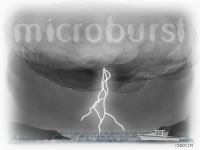Inside a Microburst
 Boating in New England has provided some unparalleled experiences for my family and I. Some of these experiences were fantastic in the most positive sense. Others, though, scared us: stormy seas, rough passages, and even one emergency. But all of these experiences have something in common: they all gave us a broader view of life, on the ocean and off, and all taught us lessons we couldn’t have learned elsewhere. The following is an reprint of an article I wrote in 1998. It was formally published in Points East magazine in the summer of 1999. This is a true account.
Boating in New England has provided some unparalleled experiences for my family and I. Some of these experiences were fantastic in the most positive sense. Others, though, scared us: stormy seas, rough passages, and even one emergency. But all of these experiences have something in common: they all gave us a broader view of life, on the ocean and off, and all taught us lessons we couldn’t have learned elsewhere. The following is an reprint of an article I wrote in 1998. It was formally published in Points East magazine in the summer of 1999. This is a true account.
According to Chapman Piloting, Seamanship & Small Boat Handling, a microburst is a “potential danger lurking within a body of a thunderstorm.” Specifically, also quoting from Chapman’s, a microburst is “a concentrated column of sinking air that spreads out in all directions when it reaches the surface, generating winds of up to 120 knots.”
I’ve read accounts of microbursts. I even know someone at our marina who was unluckily caught in one in open water a few years ago. (That person said it was the most frightening boating experience they had ever had.) I never thought that I would see this unlikely event firsthand.
It was 05:15, Monday, Sept. 7th, 1998, Labor Day. My wife, Georgann, and my two children, Sarah (eight) and Christopher Alan (seven), were moored in our new Eastern 27-foot lobsteryacht “The Keeper” (now sold) in Gosport Harbor, Isles of Shoals, approximately six nautical miles southeast of Portsmouth, NH. We were awakened by the constant thunder and nonstop lightning approaching from the southwest. The lightning was awesome, the potential magnificent, the danger not yet realized. It was then that the winds and rain began to pick up.
We were shielded by Star Island and its huge hotel, so the full force of the event may have been dampened by the obstructions. The winds came as the lightning went. Beaufort Wind Scale force six to seven started the event. Our little boat was swinging wildly back and forth, tugging hard at the mooring pennant. As the winds began to build, the side to side motion began to subside. Puzzled as to why, I peeked out the wheelhouse door. Our eight-plus foot inflatable dinghy was upside down — and its five horsepower outboard motor with a full integral tank had its drive down! This must have checked our movement.
Within a few minutes the winds increased in intensity to force ten to eleven. Our poor dinghy flipped completely over four more times (luckily ending right side up with only a half-gallon of water in it). The lightning was long forgotten as the wind and water screamed by us in a unearthly howl. Sheeting foam blew by us across the surface of the protected waters of the harbor. Looking beyond our vessel through the wheelhouse door, trying to pierce the darkness, rain and rage with a half-million candlepower spotlight, I saw madness and mayhem all around us: sailboats being blown into the rock breakwaters as their strained moorings dragged free, people’s screams intermingled with the wind, keels of sailboats slamming repeatedly into the rocky bottom as the harbor’s low-tide surface began to rise and fall with the steep four to five-footers deflected into the harbor from the west-northwest.
Ten minutes. Ten long minutes and it was over. Loose boats were still collecting themselves. Boats still hitting other boats. Anchors were being set in haste to curtail further damage. But, for the most part, it was over. The sun was coming up and starting to burn away the mess. I got our dinghy running (fortunately the fuel vent was closed) and started collecting stuff washed up on the rocks and returning it to the stunned and the dazed. I was helping the less fortunate with mundane tasks like righting dinghies, etc. Meanwhile the Coast Guard arrived to rescue a battered and swamped sailboat, and commercial towers started to help folks off the rocks.
The winds were supposedly recorded nearby at well over force twelve, I heard they were clocked in excess of 90 knots, in fact. We still boat… a lot! Some folks we used to see every weekend, though, we have not seen since. Had the microburst occurred in unprotected waters we might have perished. Perhaps this is a reality that hit others more strongly. All in all, and I certainly can’t speak for everyone, mostly just the unscathed few with whom I’ve had a chance speak to with since then, it was an educational experience. To see firsthand the awesome power of nature unleashed was something we’ll never forget. Ten minutes’ worth, that’s it. It was enough to last a lifetime!
Just for the record I’ve been in at least six hurricanes, two of which were major breaking category four limit, I’ve seen an F-three tornado, three huge water spouts, and I’ve been in five earthquakes that topped Richter scale five (the biggest was seven). By far, the worst are the earthquakes — especially when you’re awoken by them in the night, your bed literally bouncing off the floor.
